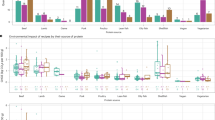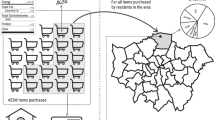Abstract
The current and growing demand for animal protein exerts immense pressure on the environment through diverse effects such as land-use change, water use and greenhouse gas emissions. Curbing meat demand by transitioning to largely plant-based diets is key to increasing food system sustainability. In this study, we investigate dietary transitions by analysing a dataset of over 240,000 recipes with 2.5 million user ratings from the most popular German recipe website. We find an increase in the vegetarian and vegan recipes submitted, with annual growth rates of 16% and 3.5%, respectively. We further detect a consistent relative increase in the number of users switching to these diets and maintaining them over the last 8 years. We show that the transition is eased by initially switching to vegetarian diets that resemble meat-based ones in their ingredient makeup. These findings are corroborated by qualitative interviews with users who have recently switched diets. Our results demonstrate the application of recipe metadata to determine individuals’ dietary choices and large-scale food trends, and identify pathways to a more sustainable food system.
This is a preview of subscription content, access via your institution
Access options
Access Nature and 54 other Nature Portfolio journals
Get Nature+, our best-value online-access subscription
$29.99 / 30 days
cancel any time
Subscribe to this journal
Receive 12 digital issues and online access to articles
$119.00 per year
only $9.92 per issue
Buy this article
- Purchase on Springer Link
- Instant access to full article PDF
Prices may be subject to local taxes which are calculated during checkout




Similar content being viewed by others
Data availability
Recipe data developed for the analyses and visualizations in this manuscript are available from the authors upon reasonable request.
Code availability
The Ipython notebooks developed for the analyses and visualizations in this manuscript are available from the authors upon reasonable request.
References
Rockström, J. et al. A safe operating space for humanity. Nature 461, 472–475 (2009).
Clark, M. & Tilman, D. Comparative analysis of environmental impacts of agricultural production systems, agricultural input efficiency, and food choice. Environ. Res. Lett. 12, 064016 (2017).
Tilman, D. & Clark, M. Global diets link environmental sustainability and human health. Nature 515, 518–522 (2014).
Vermeulen, S. J., Campbell, B. M. & Ingram, J. S. I. Climate change and food systems. Annu. Rev. Environ. Resour. 37, 195–222 (2012).
Gerber, P. et al. Tackling Climate Change through Livestock—A Global Assessment of Emissions and Mitigation Opportunities Technical Report No. 2 (FAO, 2013).
Tubiello, F. N. et al. The FAOSTAT database of greenhouse gas emissions from agriculture. Environ. Res. Lett. 8, 15009–15019 (2013).
Stoll-Kleemann, S. & Schmidt, U. J. Reducing meat consumption in developed and transition countries to counter climate change and biodiversity loss: a review of influence factors. Reg. Environ. Change 17, 1261–1277 (2017).
Westhoek H. et al. The Protein Puzzle. The Consumption and Production of Meat, Dairy and Fish in the European Union Technical Report (Netherlands Environmental Assessment Agency, 2011).
Sans, P. & Combris, P. World meat consumption patterns: an overview of the last fifty years (1961–2011). Meat Sci. 109, 106–111 (2015).
Ranganathan, J. et al. Shifting Diets for a Sustainable Future Technical Report No. 11 (World Resources Institute, 2016).
Bajželj, B. et al. Importance of food-demand management for climate mitigation. Nat. Clim. Change 4, 924–929 (2014).
Poore, J. & Nemecek, T. Reducing food’s environmental impacts through producers and consumers. Science 360, 987–992 (2018).
Westhoek, H. et al. Food choices, health and environment: effects of cutting Europe’s meat and dairy intake. Glob. Environ. Change 26, 196–205 (2014).
Garnett, T., Mathewson, S., Angelides, P. & Borthwick, F. Policies and actions to shift eating patterns: what works? (FCRN/Chatham House, 2015); http://www.fcrn.org.uk/sites/default/files/fcrn_chatham_house_0.pdf
Melina, V., Craig, W. & Levin, S. Position of the academy of nutrition and dietetics: vegetarian diets. J. Acad. Nutr. Diet. 116, 1970–1980 (2016).
Doub, A. E., Small, M. L., Levin, A., LeVangie, K. & Brick, T. R. Identifying users of traditional and Internet-based resources for meal ideas: an association rule learning approach. Appetite 103, 128–136 (2016).
Nestlé Study: So Kocht Deutschland [How Germany Cooks] https://www.nestle.de/unternehmen/publikationen/nestle-studie/sokochtdeutschland (2017).
Mouritsen, O. G., Edwards-Stuart, R., Ahn, Y.-Y. & Ahnert, S. E. Data-driven methods for the study of food perception, preparation, consumption, and culture. Front. ICT 4, 15 (2017).
Dixon, J. & Isaacs, B. Why sustainable and ’nutritionally correct’ food is not on the agenda: Western Sydney, the moral arts of everyday life and public policy. Food Policy 43, 67–76 (2013).
Hermsen, S., Frost, J., Renes, R. J. & Kerkhof, P. Using feedback through digital technology to disrupt and change habitual behavior: a critical review of current literature. Comput. Hum. Behav. 57, 61–74 (2016).
Pearson, E., Tindle, H., Ferguson, M., Ryan, J. & Litchfield, C. Can we tweet, post, and share our way to a more sustainable society? A review of the current contributions and future potential of #Socialmediaforsustainability. Annu. Rev. Environ. Resour. 41, 363–397 (2016).
Korda, H. & Itani, Z. Harnessing social media for health promotion and behavior change. Health Promot. Pract. 14, 15–23 (2013).
Kinard, B. R. Insta-grams: the effect of consumer weight on reactions to healthy food posts. Cyber. Behav. Soc. Netw. 19, 481–486 (2016).
Trattner, C., Parra, D. & Elsweiler, D. Monitoring obesity prevalence in the United States through bookmarking activities in online food portals. PLoS ONE 12, e0179144 (2017).
West, R., White, R. W. & Horvitz, E. From cookies to cooks: insights on dietary patterns via analysis of web usage logs. In Proc. 22nd International Conference on World Wide Web 1399–1410 (ACM, 2013).
Abbar, S, Mejova, Y. & Weber, I. You tweet what you eat. In Proc. 33rd Annual Conference on Human Factors in Computing Systems 3197–3206 (ACM, 2015).
Culotta, A. Estimating county health statistics with twitter. In Proc. 32nd Annual Conference on Human Factors in Computing Systems 1335–1344 (ACM, 2014).
Pila, E., Mond, J. M., Griffiths, S., Mitchison, D. & Murray, S. B. A thematic content analysis of #cheatmeal images on social media: characterizing an emerging dietary trend. Int. J. Eat. Disord. 50, 698–706 (2017).
Ahn, Y.-Y., Ahnert, S. E., Bagrow, J. P. & Barabási, A.-L. Flavor network and the principles of food pairing. Sci. Rep. 1, 196 (2011).
Zhu, Y.-X. et al. Geography and similarity of regional cuisines in China. PLoS ONE 8, e79161 (2013).
Amato, G et al. Social media image recognition for food trend analysis. In Proc. 40th International Conference on Research and Development in Information Retrieval 1333–1336 (ACM, 2017).
Choudhury, De, M., Sharma, S. & Kiciman, E. Characterizing dietary choices, nutrition, and language in food deserts via social media. In Proc. 19th Conference on Computer-Supported Cooperative Work & Social Computing 1155–1168 (ACM, 2016).
Trattner, C. & Elsweiler, D. Food recommender systems: important contributions, challenges and future research directions. Preprint at http://arxiv.org/abs/1711.02760 (2017).
Elsweiler, D., Trattner, C. & Harvey, M. Exploiting food choice biases for healthier recipe recommendation. In Proc. 40th International Conference on Research and Development in Information Retrieval 575–584 (ACM, 2017).
Trattner, C., Elsweiler, D. & Howard, S. Estimating the healthiness of internet recipes: a cross-sectional study. Front. Public Health 5, 16 (2017).
Trattner, C., Rokicki, M. & Herder, E. On the relations between cooking interests, hobbies and nutritional values of online recipes. In Adjunct Publication of the 25th Conference on User Modeling, Adaptation and Personalization 59–64 (ACM, 2017).
Rokicki, M., Trattner, C. & Herder, E. The impact of recipe features, social cues and demographics on estimating the healthiness of online recipes. In Proc. 12th International Conference on Web and Social Media (AAAI, 2018).
Trattner, C. & Elsweiler, D. Investigating the healthiness of internet-sourced recipes. In Proc. 26th International Conference on World Wide Web 489–498 (ACM, 2017).
Trattner, C., Kusmierczyk, T. & Nørvåg, K. Investigating and predicting online food recipe upload behavior. Inf. Process. Manag. 56, 654–673 (2019).
Wagner, C. & Strohmaier, M. Spatial and temporal patterns of online food preferences categories and subject descriptors. In Proc. 23rd International Conference World Wide Web 553–554 (ACM, 2014).
Vegetarismus und Veganismus [Vegetarianism and Veganism] (Statista, 2018); https://de-statista-com.pxz.iubh.de:8443/statistik/studie/id/27956/dokument/vegetarismus-und-veganismus-statista-dossier/
Woher nehmen Sie die Inspiration, welche Gerichte Sie einkaufen bzw. kochen wollen? [Where do you get Inspiration from, for the Dishes you want to buy or cook?] (Statista, 2018); https://de.statista.com/statistik/daten/studie/305898/umfrage/umfrage-in-deutschland-zu-den-rezept-quellen-fuer-selbstgekochte-gerichte/
Anzahl der Veganer und Vegetarier in Deutschland [Number of Vegans and Vegetarians in Germany] (ProVeg, 2017); https://vebu.de/veggie-fakten/entwicklung-in-zahlen/anzahl-veganer-und-vegetarier-in-deutschland/
Rockström, J. et al. Planetary boundaries: exploring the safe operating space for humanity. Ecol. Soc. 14, 32 (2009).
Springmann, M. et al. Options for keeping the food system within environmental limits. Nature 562, 519–525 (2018).
Vollwertig essen und trinken nach den 10 Regeln der DGE [Balanced Eating and Drinking According to the 10 Rules of the German Nutrition Society] (DGE, 2018); https://www.dge.de/fileadmin/public/doc/fm/10-Regeln-der-DGE.pdf
Verbrauch von Nahrungsmitteln je Kopf der Bevölkerung [Consumption of Food per Capita] (BMEL, 2017); http://www.bmel-statistik.de/fileadmin/user_upload/monatsberichte/MBT-0207030-0000.xls
Apostolidis, C. & McLeay, F. Should we stop meating like this? Reducing meat consumption through substitution. Food Policy 65, 74–89 (2016).
Schösler, H., de Boer, J. & Boersema, J. J. Can we cut out the meat of the dish? Constructing consumer-oriented pathways towards meat substitution. Appetite 58, 39–47 (2012).
Lorenz, B. A. & Langen, N. Determinants of how individuals choose, eat and waste: providing common ground to enhance sustainable food consumption out-of-home. Int. J. Consum. Stud. 42, 35–75 (2018).
Marteau, T. M. Towards environmentally sustainable human behaviour: targeting non-conscious and conscious processes for effective and acceptable policies. Phil. Trans. R. Soc. A. 375, 20160371 (2017).
Anzahl der Unique User von Chefkoch.de von Juli 2017 bis Juli 2018 (in Millionen) [Number of Unique Users of Chefkoch.de from July 2017 to July 2018 (in Millions)] (AGOF, 2018); https://de.statista.com/statistik/daten/studie/417965/umfrage/online-besucherzahlen-von-chefkoch-als-zeitreihe/
Netto-Reichweiten der Top-20 mobilen Online-Angebote (ab 10 Jahre) im Juli 2018 (in Millionen Unique User) [Net Reach of the Top 20 Online Mobile Offerings (Over 10 Years Old) in July 2018 (in Millions of Unique Users)] (AGOF, 2018); https://de.statista.com/statistik/daten/studie/164615/umfrage/mobile-facts-2010—top-20-mobile-enabled-websites/
Netto-Reichweiten der Top-20-Online-Angebote (ab 10 Jahre) im Juli 2018 (in Millionen Unique Usern) [Net Reach of the Top 20 Online Offerings (Over 10 Years Old) in July 2018 (in Millions of Unique Users)] (AGOF, 2018); https://de.statista.com/statistik/daten/studie/164759/umfrage/die-zwanzig-groessten-online-angebote-in-deutschland/
Ilieva, R. T. & McPhearson, T. Social-media data for urban sustainability. Nat. Sustain. 1, 553–565 (2018).
Kuckartz, U. Qualitative Text Analysis: A Guide to Methods, Practice & Using Software (SAGE, 2014).
Omohundro, S. M. Five balltree construction algorithms. Science 51, 1–22 (1989).
Hamming, R. W. Error detecting and error correcting codes. Bell Syst. Tech. J. 29, 147–160 (1950).
Theil, H. Economic Policy and Forecasting (North-Holland, 1961).
Acknowledgements
The authors thank L. Biermann for his support. Y.M.A. is funded by the EPSRC Centre for Doctoral Training in Autonomous Intelligent Machines & Systems (EP/L015897/1).
Author information
Authors and Affiliations
Contributions
Y.M.A. and G.B. jointly conceived the study and analysed the data. Y.M.A. and G.B. both interpreted the results, wrote the paper and approved the submitted version.
Corresponding author
Ethics declarations
Competing interests
The authors declare no competing interests.
Additional information
Publisher’s note: Springer Nature remains neutral with regard to jurisdictional claims in published maps and institutional affiliations.
Supplementary information
Supplementary Information
Supplementary Figs. 1–3, Supplementary Tables 1–4
Rights and permissions
About this article
Cite this article
Asano, Y.M., Biermann, G. Rising adoption and retention of meat-free diets in online recipe data. Nat Sustain 2, 621–627 (2019). https://doi.org/10.1038/s41893-019-0316-0
Received:
Accepted:
Published:
Issue Date:
DOI: https://doi.org/10.1038/s41893-019-0316-0
This article is cited by
-
Carbon footprint and embodied nutrition evaluation of 388 recipes
Scientific Data (2023)
-
Tesco Grocery 1.0, a large-scale dataset of grocery purchases in London
Scientific Data (2020)
-
What online data say about eating habits
Nature Sustainability (2019)



